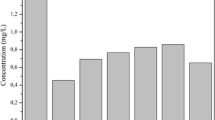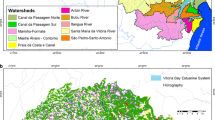Abstract
This paper presents the development of an export coefficient model to characterise the rates and sources of P export from land to water in four reservoir systems located in a semi-arid rural region in southern of Portugal. The model was developed to enable effective management of these important water resource systems under the EU Water Framework Directive. This is the first time such an approach has been fully adapted for the semi-arid systems typical of Mediterranean Europe. The sources of P loading delivered to each reservoir from its catchment were determined and scenario analysis was undertaken to predict the likely impact of catchment management strategies on the scale of rate of P loading delivered to each water body from its catchment. The results indicate the importance of farming and sewage treatment works/collective septic tanks discharges as the main contributors to the total diffuse and point source P loading delivered to the reservoirs, respectively. A reduction in the total P loading for all study areas would require control of farming practices and more efficient removal of P from human wastes prior to discharge to surface waters. The scenario analysis indicates a strategy based solely on reducing the agricultural P surplus may result in only a slow improvement in water quality, which would be unlikely to support the generation of good ecological status in reservoirs. The model application indicates that a reduction of P-inputs to the reservoirs should first focus on reducing P loading from sewage effluent discharges through the introduction of tertiary treatment (P-stripping) in all major residential areas. The fully calibrated export coefficient modelling approach transferred well to semi-arid regions, with the only significant limitation being the availability of suitable input data to drive the model. Further studies using this approach in semi-arid catchments are now needed to increase the knowledge of nutrient export behaviours in semi-arid regions.





Similar content being viewed by others
Notes
Please see ‘Acknowledgements’ section for a list of experts interviewed.
The accumulated organic matter in these systems are periodically pumped out and taken to a nearby STW for disposal.
References
Alvarez-Cobelas M, Sánchez-Andrés R, Sánchez-Carrillo S, Angeler DG (2010) Nutrient contents and export from streams in semiarid catchments of central Spain. J Arid Environ 74(8):933–945
Alves AL, Carvalho NS, Castel-Branco da Silveira S, Marques JP, Costa Z, Horta ALL (2003) The abandonment of agriculture. Agro-Environmental Working Group. Ministry of Agriculture, Rural Development and Fisheries and Ministry of the Environment and Ordenamento do Território, Lisbon [In Portuguese]
Anbazhagan S, Ramasamy SM, Das Gupta S (2005) Remote sensing and GIS for artificial recharge study, runoff estimation and planning in Ayyar Basin, Tamil Nadu, India. Environ Geology 48(2):158–170
Bowes MJ, Smith JT, Jarvie HP, Neal C (2008) Modelling of phosphorus inputs to rivers from diffuse and point sources. Sci Total Environ 395:125–138
Brandjes PJ, de Wit J, Van der Meer HG, Van Keulen H (1996) Environmental impact of animal manure management. Wageningen, International Agriculture Centre, The Netherlands
Brett MT, Benjamin MM (2008) A reassessment of lake phosphorus retention and the nutrient loading concept in limnology. Freshw Biol 53:194–211
Cabecinha E, Lourenço M, Moura JP, Pardal MA, Cabral JÁ (2009a) A multi-scale approach to modelling spatial and dynamic ecological patterns for reservoir’s water quality management. Ecol Model 220(19):2559–2569
Cabecinha E, Cortes R, Pardal MA, Cabral JÁ (2009b) A Stochastic Dynamic Methodology (StDM) for reservoir’s water quality management: Validation of a multi-scale approach in a south European basin (Douro, Portugal). Ecol Indic 9(2):329–345
Cao W, Bowden WB, Davie T et al (2009) Modelling Impacts of Land Cover Change on Critical Water Resources in the Motueka River Catchment, New Zealand. Water Resour Manage 23(1):137–151
Cerqueira MA, Silva JF, Magalhães FP, Soares FM, Pato JJ (2008) Assessment of water pollution in the Antuã River basin (Northwestern Portugal). Environ Monit Assess 142:325–335
Diogo PA, Fonseca M, Coelho PS, Mateus NS, Almeida MC, Rodrigues AC (2008) Reservoir phosphorus sources evaluation and water quality modelling in a transboundary watershed. Desalination 226:200–214
European Commission (2002) Common Implementation Strategy for the Water Framework Directive. Guidance Document No. 3, Analysis of Pressures and Impacts. The Directorate General Environment of the European Commission, Brussels
European Commission (2006) Rural Development in the European Union—Statistical and Economic Information. European Commission, Directorate-General for Agriculture and Rural Development, Brussels
European Communities (2006) European Communities Good Agricultural Practices for Protection of Waters. Regulations 2006, S.I. No. 378 of 2006. The Stationery Office, Dublin
Foy RH, Lennox SD, Gibson CE (2003) Changing perspectives on the importance of urban phosphorus inputs as the cause of nutrient enrichment in Lough Neagh. Sci Total Environ 310(1–3):87–99
Geraldes AM, Boavida MJ (2003) Distinct age and landscape influence on two reservoirs under the same climate. Hydrobiol 504:277–288
Ierodiaconou D, Laurenson L, Leblanc M et al (2005) The consequences of land use change on nutrient exports: a regional scale assessment in south-west Victoria, Australia. J Environ Manag 74:305–316
INAG (Instituto da Água) (2002) Sado River Basin Management Plan – Final Report. Ministério do Ambiente e do Ordenamento do Território, Lisboa
INAG (Instituto da Água) (2009) Sado and Mira Hydrographic Region: Water Management Issues. National Water Institute and Administration of Alentejo Hydrographic Region, Lisboa
INAG (Instituto da Água) (2010) National Information System of Hydrologic Resources. http://snirh.pt. Accessed 30 January 2010
INIA-LQARS (Instituto Nacional de Investigação Agrária – Laboratório Químico Agrícola Rebelo da Silva) (2005) Fertilisation manual of cultivated crops.Ministry of Agriculture, Rural Development and Fisheries, Lisboa [In Portuguese]
INSAAR (Inventário Nacional de Sistemas de Abastecimento de Água e de Águas Residuais) (2009) National Inventory of Water Supply Systems and Sewage Treatment Plants. http://insaar.inag.pt/. Accessed 28 December 2009
Jarvie HP, Neal C, Withers PJA (2006) Sewage-effluent phosphorus: a greater risk to river eutrophication than agricultural phosphorus? Sci Total Environ 360(1–3):246–253
Johnes PJ (1996) Evaluation and management of the impact of land use on the nitrogen and phosphorus load delivered to surface waters: the export coefficient modelling approach. J Hydrol 183:323–349
Johnes PJ (1999) Understanding lake and catchment history as a tool for integrated lake management. Hydrobiol 395:41–60
Johnes PJ (2000) Quantifying the non-point source contribution to nutrient loading on freshwaters in 32 UK catchments. Verh Int Verein Limnol 27:1306–1309
Jones RA, Lee GF (1982) Recent advances in assessing impact of phosphorus loads on eutrophication-related water quality. Water Res 16(5):503–515
Johnes PJ, Heathwaite AL (1997) Modelling the impact of land use change on water quality in agricultural catchments. Hydrol Process 11:269–286
Johnes PJ, Butterfield D (2002) Landscape, regional and global estimates of nitrogen flux from land to sea: errors and uncertainties. Biogeochem 57(58):429–476
Johnes PJ, Moss B, Phillips GL (1996) The determination of water quality by land use livestock numbers and population data – testing of a model for use in conservation and water quality management. Freshw Biol 36:451–473
Johnes PJ, Foy R, Butterfield D, Haygarth PM (2007) Land use scenarios for England and Wales: evaluation of management options to support ‘good ecological status’ in surface freshwaters. Soil Use Manag 23:176–194
Lepistö A, Granlunda K, Kortelainena P, Räike A (2006) Nitrogen in river basins: Sources, retention in the surface waters and peatlands, and fluxes to estuaries in Finland. Sci Total Environ 365(1–3):238–259
Lunn RJ, Adams R, Mackay R, Dunn SM (1996) Development and application of a nitrogen modelling system for large catchments. J Hydrol 174:285–304
Matias NG, Boavida MJ (2005) Effects of catchment development on the trophic status of a deep and a shallow reservoir in Portugal. Lake Reserv Manag 21(3):350–360
Matias NG, Gago J, Boavida MJ (2008) Catchment consultation for water management: the case of two Portuguese reservoirs with different water quality. Int J Environ Stud 65(6):737–754
MADRP (Ministério da Agricultura, do Desenvolvimento Rural e das Pescas) (2000) Basic Manual of Agricultural Practices: Soil and water conservation. Ministry of Agriculture, Rural Development and Fisheries Publications, Lisboa [In Portuguese]
National Statistics Institute (Instituto Nacional de Estatística, Portugal) (2001a) Territorial Census. National Statistics Institute of Portugal, Lisboa
National Statistics Institute (Instituto Nacional de Estatística, Portugal) (2001b) Agricultural Census. National Statistics Institute of Portugal, Lisboa
Nunes JM, Pereira S, Albardeiro A, Silva C, López-Piñero A, Pintado C (2001) Potentialities of olive mill waste utilisation as organic fertiliser for Mediterranean Region soils. Revista de Ciências Agrárias 24(3/4):116–175
Nunes JP, Seixas J, Pacheco NR (2007) Vulnerability of water resources, vegetation productivity and soil erosion to climate change in Mediterranean watersheds. Hydrol Process 22(16):3115–3134
OECD (1982) Eutrophication of waters: Monitoring, assessment, and control. Organisation for Economic Co-operation and Development, Paris
Olsson JA, Andersson L (2007) Possibilities and problems with the use of models as a communication tool in water resource management. Water Resour Manage 21:97–110
Portuguese Environmental Agency (Agência Portuguesa do Ambiente) (2010) Corine Land Cover 1990 and 2006. http://www.apambiente.pt. Accessed 3 January 2010
Reckhow KH, Simpson JJ (1980) A procedure using modelling and error analysis for prediction of lake phosphorus from land use information. Can J Fish Aquat Sci 37:1439–1448
Salvia-Castellví M, Iffly JF, Borght PV, Hoffmann L (2005) Dissolved and particulate nutrient export from rural catchments: A case study from Luxembourg. Sci Total Environ 344(1–3):51–65
Skop E, Sorensen PB (1998) GIS-based modelling of solute fluxes at the catchment scale: a case study of the agricultural contribution to the riverine nitrogen loading in the Vejle Fjord catchment, Denmark. Ecol Model 106:291–310
Smith RV, Jordan C, Annett JA (2005) A phosphorus budget for Northern Ireland: inputs to inland and coastal waters. J Hydrol 304:193–202
Soares FB, Coelho C (2004) Analysis of the impact of the Luxembourg agreement on reform of the common agricultural policy on the agri-food sector of Portugal: an application of the AG-MEMOD model. Paper prepared for the Fourth National Meeting of Agricultural Economists, Faro, Portugal
Soranno PA, Hubler SL, Carpenter SR, Lathrop RC (1996) Phosphorus loads to surface waters: a simple model to account for spatial pattern of land use. Ecol Applic 6:865–878
Styczen M, Storm B (1993) Modelling of N-movements on catchment scale-a tool for analysis and decision making. I. Model description. Fert Res 36:1–6
Tranter RB, Swinbank A, Wooldridge MJ et al (2007) Implications for food production, land use and rural development of the European Union’s Single Farm Payment: Indications from a survey of farmers’ intentions in Germany, Portugal and the UK. Food Policy 32:656–671
Urban Waste Water Treatment Directive (UWWT; 91/271/EEC): OJ L135 40–52,1991. Amended to clarify standards for total N and P by Directive 98/15/EEC, OJ 67 29–30, 1998.
Water Framework Directive (2000/60/EC): OJ L327 1–72, 2000
Acknowledgements
The first author was supported in part by a doctoral fellowship granted by the Foundation for Science and Technology from Portugal (grant SFRH/BD/17786/2004). Total phosphorus data for model validation was kindly provided by Ana Ilhéu and Rosário Costa on behalf of EDIA. Special thanks to Nuno Cavaco for the help with the catchment land use spatial analysis approach. The authors would like to acknowledge the important contribution of all people consulted in this study, who contributed with ideas, perspectives and specialist knowledge which have greatly enhanced the content of this work. Namely, António Fabião, Ernesto Vasconcelos, and Manuel Madeira from the Higher Institute of Agronomy; Maria da Conceição Gonçalves, José Casimiro Martins, and Tiago Brito Ramos from the Department of Soil Sciences, Estação Agronómica Nacional; Maria João Rasga and Rui Ramos from Laboratório de Évora da CCDR do Alentejo; João Pádua from INAG; Bob Foy (Agricultural and Environmental Science Division, Belfast, UK), Crawford Jordan (Agriculture, Food and Environmental Sciences Division, Agri-Food & Biosciences Institute, Belfast, UK), Joan Armengol (Department of Ecology, University of Barcelona), João Pedro Nunes (Department of Environmental Science and Engineering, Faculty of Sciences and Technology), and Luís Coelho Silva.
The authors thank the journal editor and the anonymous reviewers for their thoughtful and insightful comments toward improving the final article.
Author information
Authors and Affiliations
Corresponding author
Rights and permissions
About this article
Cite this article
Matias, NG., Johnes, P.J. Catchment Phosphorous Losses: An Export Coefficient Modelling Approach with Scenario Analysis for Water Management. Water Resour Manage 26, 1041–1064 (2012). https://doi.org/10.1007/s11269-011-9946-3
Received:
Accepted:
Published:
Issue Date:
DOI: https://doi.org/10.1007/s11269-011-9946-3




